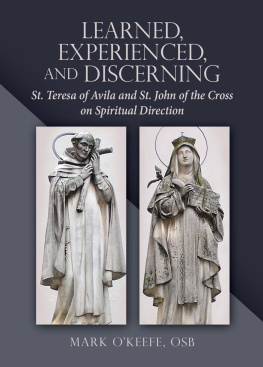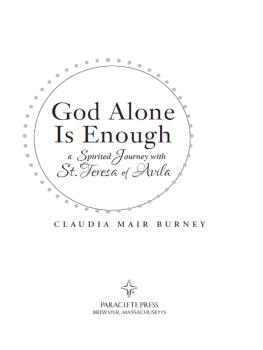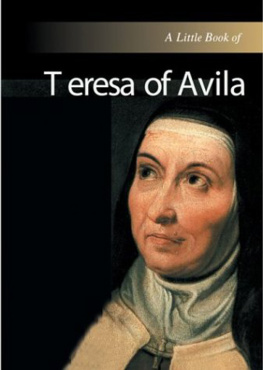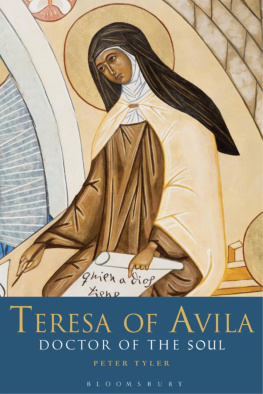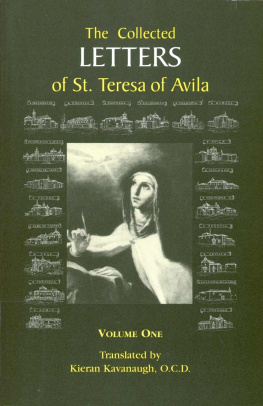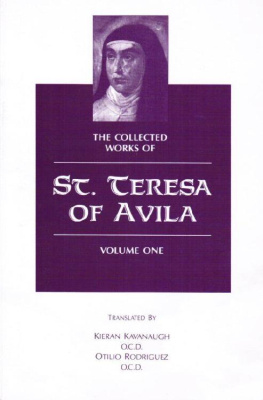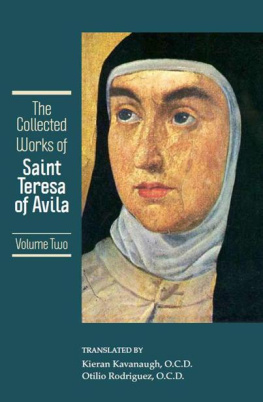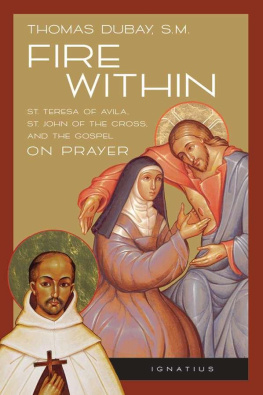Cover design by Monica Bokinskie. Statues of Saint John of the Cross and Saint Teresa of Avila, Plaza de las Carmelitas, Spain. Photos courtesy of Wikimedia Commons (CC-BY-SA 2.0).
Excerpts from The Collected Works of St. Teresa of Avila, Volume One , translated by Kieran Kavanaugh and Otilio Rodriguez Copyright 1976 by Washington Province of Discalced Carmelites; The Collected Works of St. Teresa of Avila, Volume Two , translated by Kieran Kavanaugh and Otilio Rodriguez Copyright 1980 by Washington Province of Discalced Carmelites; The Collected Works of St. Teresa of Avila, Volume Three , translated by Kieran Kavanaugh and Otilio Rodriguez Copyright 1980 by Washington Province of Discalced Carmelites; The Collected Works of St. John of the Cross , translated by Kieran Kavanaugh and Otilio Rodriguez Copyright 1964, 1979, 1991 by Washington Province of Discalced Carmelites. ICS Publications 2131 Lincoln Road, N.E. Washington, DC 20002-1199 U.S.A. www.icspublications.org.
2020 by Mark OKeefe, OSB
Published by Liturgical Press, Collegeville, Minnesota. All rights reserved. No part of this book may be used or reproduced in any manner whatsoever, except brief quotations in reviews, without written permission of Liturgical Press, Saint Johns Abbey, PO Box 7500, Collegeville, MN 56321-7500. Printed in the United States of America.
Library of Congress Cataloging-in-Publication Data
Names: OKeefe, Mark, 1956 author.
Title: Learned, experienced, and discerning : St. Teresa of Avila and St. John of the Cross on spiritual direction / Mark OKeefe, OSB.
Description: Collegeville, Minnesota : Liturgical Press, [2020] | Includes bibliographical references. | Summary: Insights into the qualities that should mark a good spiritual director-learned, experienced, and discerning-as demonstrated by the spiritual texts of Teresa of Avila and John of the Cross Provided by publisher.
Identifiers: LCCN 2019055214 (print) | LCCN 2019055215 (ebook) | ISBN 9780814688106 (paperback) | ISBN 9780814688342 (epub) | ISBN 9780814688342 (mobi) | ISBN 9780814688342 (pdf)
Subjects: LCSH: Spiritual directionCatholic Church. | Spiritual directors. | CarmelitesSpiritual life. | Teresa, of Avila, Saint, 1515-1582. | John of the Cross, Saint, 1542-1591.
Classification: LCC BX2350.7 .O54 2020 (print) | LCC BX2350.7 (ebook) | DDC 253.5/3dc23
LC record available at https://lccn.loc.gov/2019055214
LC ebook record available at https://lccn.loc.gov/2019055215
Acknowledgments
This work began at the suggestion of Dr. Robert Alvis, academic dean at Saint Meinrad Seminary and School of Theology, where I am privileged to serve on the faculty. I am grateful to him for his encouragement and to my faculty colleagues for their collegial support. The Spanish-language research for the project was conducted in the excellent library of the Centro Internacional Teresiano Sanjuanista (Universidad de la Mstica) in Avila, Spain. I am grateful to the staff there for their support and friendship. Fr. J. Lawrence Richardt, a priest of the Archdiocese of Indianapolis, kindly read over and made suggestions that have improved this text. But I am especially grateful to Larry for the many years that he has served as my own spiritual director through a journey with inevitable twists and turns. He is, in my experienceand that of many others, I am surea truly learned, experienced, and discerning director. With great respect and heartfelt appreciation for his ministry, I dedicate this book to him.
Translations and Abbreviations
All quotations from the works of Teresa of Avila are taken from The Collected Works of St. Teresa of Avila , translated by Kieran Kavanaugh, OCD, and Otilio Rodriguez, OCD, 3 vols. (Washington, DC: ICS Publications, 19761985, 1987, 2012).
The following abbreviations will be used in references to Teresas works:
F = The Book of Her Foundations
L = The Book of Her Life
M = Meditations on the Song of Songs
W = The Way of Perfection
IC = The Interior Castle
LE = Letters
S = Soliloquies
ST = Spiritual Testimonies
References to particular texts within these works is indicated in the following way:
For the first four works, the first number refers to the chapter, and the second number refers to the paragraph. Thus, W 3.5 refers to The Way of Perfection , chapter 3, paragraph 5.
Regarding The Interior Castle , the first number refers to the dwelling place, the second number refers to the chapter, and the third number refers to the paragraph. Thus, IC 3.4.2 refers to the third dwelling place, chapter 4, paragraph 2.
All quotations from the works of John of the Cross are taken from The Collected Works of St. John of the Cross , rev. ed., translated by Kieran Kavanaugh, OCD, and Otilio Rodriguez, OCD (Washington, DC: ICS Publications, 1991).
The following abbreviations will be used in references to Johns works:
A = The Ascent of Mount Carmel
C = The Spiritual Canticle
F = The Living Flame of Love
L = Letters
N = The Dark Night
Pre = The Precautions
SLL = The Sayings of Light and Love
References to particular texts within these works is indicated in the following way:
For The Ascent of Mount Carmel and The Dark Night , the first number indicates the book, the second number refers to the chapter, and the third number indicates the paragraph. For example: A 2.3.4 would refer to the Ascent , book two, chapter 3, paragraph 4.
In a similar manner, for The Spiritual Canticle and The Living Flame of Love , the first number refers to the stanza and the second number to the paragraph. Thus, C 3.4 is a reference to the commentary on stanza 3, paragraph 4 of The Spiritual Canticle .

Part One
Preliminary Considerations
Before we examine more directly what Teresa of Avila and John of the Cross have to say about spiritual direction, we begin by looking at the lens that we will apply to our study. When we speak of their view on spiritual direction, how do we understand today what the term spiritual direction means? From our contemporary perspective, what does the relationship of director and directee involve? Our starting point will influence what we are looking for in their writings and what we choose to highlight. On the other hand, our own contemporary understanding of the topic can be expanded or clarified by what we find. In fact, I will suggest that this is precisely the case.
These two Carmelite Doctors of the Church wrote what have become spiritual classics whose insights transcend their own particular audience and time. And yet, what we are examining from our contemporary perspective involves what was formulated and written for a people of another time and culture. Without some understanding of the distinctive world in which Teresa and John lived and wrote, we might misunderstand what they are trying to express in their own terms and with their particular emphases.
Chapter Four
The Three Essential Characteristics
All Three of Them
Amid the spiritual fervor of sixteenth-century Spain, the Franciscans in particular developed and encouraged a life of prayer deeper than external rituals and established prayers and devotions. It was from their tradition that Teresa learned the prayer of recollection: the drawing in or gathering of the senses and conscious attention into quiet, wordless prayer, first by our own graced effort and then hopefully by the gifted work of God. But the Franciscans went further by encouraging such prayer among ordinary peoplelaywomen and laymen as well as religious and priests. This development was opposed by many academically educated clergy (and later by the Inquisition) as dangerous in a time of poor catechesis and illiteracy, especially among women (including nuns). Conflict arose among those with learning ( letrados ) and those with experience ( espirituales ). Those with academic degrees warned of the dangers of heresy arising among those misguided by their felt experiences of God, while those who had enjoyed a depth of prayer argued that dry academic learning could offer very little to the actual mature spiritual life of the faithful. But both Teresa and John bridged this divide by insisting on the necessity of both learning and actual spiritual experience in those who would guide otherseducation and experience joined with a spiritual prudence and discernment in assisting others on the Christian path.

